Evolution of Pore Structure and Fractal Characteristics in Transitional Shale Reservoirs: Case Study of Shanxi Formation, Eastern Ordos Basin
Abstract
1. Introduction
2. Geological Setting
3. Materials, Experiments and Theories
3.1. Sample
3.2. Experiments
3.3. Fractal Dimension Calculation
3.3.1. Fractal Dimension Calculation Based on LTNA Data
3.3.2. Fractal Dimension Calculation Based on MICP Data
4. Results
4.1. Mineralogy and Geochemical Characteristics of Shale
4.2. Porosity and Pore Structure Characteristics
4.2.1. Porosity Characterization
4.2.2. LTNA and MICP Curves
4.2.3. Pore Size Distribution and Pore Structure Parameters
4.3. SEM Image Analysis
4.3.1. Organic Pores and Organic-Matter-Related Microfractures
4.3.2. Inorganic Pores and Microfractures
4.4. Multifractal Characteristics
4.4.1. Fractal Dimension Based on LTNA
4.4.2. Fractal Dimension Based on MICP
5. Discussion
5.1. Relationship Between Fractal Dimension and Porosity and Pore Structure
5.2. Controlling Factors of Fractal Dimension
5.3. Evolution Model of Fractal Dimension
- (1)
- Immature-to-low-mature stage (Ro < 0.7%): Compaction causes inorganic minerals and organic matter to become tightly packed. The pore system is dominated by residual primary intergranular pores. Pore development gradually declines. As a result, D1 exhibits low values, indicating smooth pore surfaces with low complexity and high self-similarity. In the early stage of pore structure evolution, the “depleted” components in shale have not yet undergone mineral transformation. D2 shows relatively high values, reflecting the irregular development of various pore types and greater internal pore complexity.
- (2)
- Mature stage (0.7% < Ro < 1.3%): In the early part of the mature stage, the pyrolysis of kerogen releases hydrocarbons, causing a shrinkage in the kerogen volume. At the same time, complex organic pores and microfractures form on the surface and edges of the kerogen. The complexity of the pore surface increases, and D1 shows a slight rise. As hydrocarbon generation intensifies, the residual inorganic and organic pores become filled with adsorbed and retained oil, leading to a significant decrease in pore quantity during this stage. As the pore volume (PV) and specific surface area (SSA) of most pores decrease, D1 also declines overall. In the later part of the mature stage, the cracking and expulsion of retained oil releases some inorganic pores, while solid bitumen forms, enriched with nanoscale organic pores. The number of pores significantly increases, likely due to the transformation of 1–5 nm pores into pores greater than 5 nm in size. The proportion of organic pores continues to rise. A significant number of different pore types are formed, resulting in a marked increase in D1. Organic acids released during organic matter cracking promote dissolution and the transformation of clay minerals. As organic matter, feldspar, carbonate minerals, and clay minerals are progressively consumed, the complexity of the pore structure gradually decreases, and D2 continues to decline.
- (3)
- Highly mature stage (1.3% < Ro < 2.0%): Kerogen and retained oil are gradually cracked into light oil and wet gas. A significant number of organic pores form on the surface of organic matter, leading to a marked increase in D1. Inorganic pores filled with retained oil are released, which may result in a more complex internal pore structure, causing a notable increase in D2. As the oil generation capacity of kerogen gradually ceases, organic acids are no longer released, and the diagenetic environment shifts to an alkaline one. Although dissolution is weakened, the transformation of kaolinite significantly intensifies. Inorganic pores related to clay minerals (especially those in the 5–60 nm range) increase significantly, and pore development continues to advance. As a result, D1 continues to rise while D2 gradually declines.
- (4)
- Over-mature stage (Ro > 2.0%): Alkyl side chains of kerogen are cracked to form light hydrocarbons (C1–C4). The residual oil and wet gas are cracked into methane. The cracking of oil generates large amounts of methane, which helps maintain pore pressure. As a result, the number and size of organic pores reach their maximum values at Ro = 2.7% and then stabilize. In the early part of the over-mature stage, the scale of inorganic pores slightly decreases due to compaction. Due to the weak thermal evolution of organic matter and limited inorganic diagenesis, the complexity of pore surfaces gradually decreases, with D1 reaching its minimum value at this stage. In the later part of the over-mature stage, as kaolinite fully transforms into illite, the proportion of inorganic pores and microfractures increases. As a result, D1 significantly increases while D2 decreases.
6. Conclusions
- (1)
- The initial samples used for thermal simulation were primarily composed of quartz (39.9%) and clay minerals (49.9%), with moderate-to-good hydrocarbon generation potential. As thermal maturity increased, the quartz content gradually rose while the amounts of clay minerals, carbonate minerals, pyrite, and feldspar decreased. The pore evolution process consists of five stages: a slow decrease phase (0.78 < Ro < 1.0%), a rapid increase phase (1.0% < Ro < 2.0%), a relatively stable phase (2.0% < Ro < 2.7%), a rapid increase phase (2.7% < Ro < 3.2%), and a slow decrease phase (Ro > 3.2%).
- (2)
- The evolution of the pore volume (PV) and specific surface area (SSA) indicated a gradual increase in the proportion of pores in the 5–20 nm and 20–60 nm ranges while the proportion of pores smaller than 5 nm decreased. The D1 value obtained using the FHH model (average = 2.61) was higher than the D2 value (average = 2.56). This suggests that, at various stages of maturity, the roughness of pore surfaces is greater than the complexity of the internal pore structure. The DM distribution calculated using the capillary bundle model had a broad range (2.47 to 2.94), with an average value (2.84) higher than both D1 and D2, possibly indicating that larger pores exhibit more complex pore structures.
- (3)
- D1 can be used to indicate the extent of pore development. D2 can be used to characterize the changes in consumed components during the pore development process. Based on the thermal evolution of organic matter, mineral composition, diagenesis, and pore structure evolution, an evolutionary model of the fractal dimensions for transitional shales has been established.
Author Contributions
Funding
Institutional Review Board Statement
Informed Consent Statement
Data Availability Statement
Conflicts of Interest
References
- Mandelbrot, B. How long is the coast of Britain? Statistical self-similarity and fractional dimension. Science 1967, 156, 636–638. [Google Scholar] [CrossRef] [PubMed]
- Mandelbrot, B. Fractals: Form, Chance and Dimension; Freeman: San Francisco, CA, USA, 1977. [Google Scholar]
- Li, J.; Zheng, B. A new method for fractal characterization of microscopic pores and its application in shale reservoirs. Nat. Gas Ind. 2016, 35, 52–59, (In Chinese with English abstract). [Google Scholar]
- Peng, N.; He, S.; Hu, Q.; Zhang, B.; He, X.; Zhai, G.; He, C.; Yang, R. Organic nanopore structure and fractal characteristics of Wufeng and lower member of Longmaxi shales in southeastern Sichuan, China. Mar. Pet. Geol. 2019, 103, 456–472. [Google Scholar] [CrossRef]
- Huang, W.; Lu, S.; Hersi, O.; Wang, M.; Deng, S.; Lu, R. Reservoir spaces in tight sandstones: Classification, fractal characters, and heterogeneity. J. Nat. Gas Sci. Eng. 2017, 46, 80–92. [Google Scholar] [CrossRef]
- Guan, Q.; Dong, D.; Sun, S.S.; Hu, L.; Qi, L.; Li, C.; Chen, C.; Chen, X. Fractal characteristics of organic-rich shale pore structure and its geological implications: A case study of the Lower Silurian Longmaxi Formation in the Weiyuan block, Sichuan Basin. Nat. Gas Ind. 2024, 44, 108–118, (In Chinese with English abstract). [Google Scholar]
- Guo, X.; Huang, Z.; Zhao, L.; Han, W.; Ding, C.; Sun, X.; Yan, R.; Zhang, T.; Yang, X.; Wang, R. Pore structure and multi-fractal analysis of tight sandstone using MIP, NMR and NMRC methods: A case study from the Kuqa depression, China. J. Pet. Sci. Eng. 2019, 178, 544–558. [Google Scholar] [CrossRef]
- Ma, X.; Guo, S.; Shi, D.; Zhou, Z.; Liu, G. Investigation of pore structure and fractal characteristics of marine continental transitional shales from Longtan Formation using MICP, gas adsorption, and NMR (Guizhou, China). Mar. Pet. Geol. 2019, 107, 555–571. [Google Scholar] [CrossRef]
- Sun, W.; Zuo, Y.; Wu, Z.; Liu, H.; Xi, S.; Shui, Y.; Wang, J.; Liu, R.; Lin, J. Fractal analysis of pores and the pore structure of the Lower Cambrian Niutitang shale in northern Guizhou province: Investigations using NMR, SEM and image analyses. Mar. Pet. Geol. 2019, 99, 416–428. [Google Scholar] [CrossRef]
- Avnir, D.; Jaroniec, M. An isotherm equation for adsorption on fractal surfaces of heterogeneous porous materials. Langmuir 1989, 5, 1431–1433. [Google Scholar] [CrossRef]
- Neimark, A.V.; Unger, K.K. Method of discrimination of surface fractality. J. Colloid Interface Sci. 1993, 158, 412–419. [Google Scholar] [CrossRef]
- Pfeifer, P.; Wu, Y.; Cole, M.W.; Krim, J. Multilayer adsorption on a fractally rough surface. Phys. Rev. Lett. 1989, 62, 1997–2000. [Google Scholar] [CrossRef] [PubMed]
- Washburn, E.W. The dynamics of capillary flow. Phys. Rev. 1921, 2, 273–283. [Google Scholar] [CrossRef]
- Zhang, B.; Li, S. Determination of the surface fractal dimension for porous media by mercury porosimetry. Ind. Eng. Chem. Res. 1995, 34, 1383–1386. [Google Scholar] [CrossRef]
- He, T.; Zhou, Y.; Chen, Z.; Zhang, Z.; Xie, H.; Shang, Y.; Cui, G. Fractal Characterization of the Pore-Throat Structure in Tight Sandstone Based on Low-Temperature Nitrogen Gas Adsorption and High-Pressure Mercury Injection. Fractal Fract. 2024, 8, 356. [Google Scholar] [CrossRef]
- Zhang, C.; Guan, P.; Zhang, J.; Liang, X.; Ding, X.; You, Y. A Review of the Progress on Fractal Theory to Characterize the Pore Structure of Unconventional Oil and Gas Reservoirs. Acta Sci. Nat. Univ. Pekin. 2023, 59, 897–908, (In Chinese with English abstract). [Google Scholar]
- Qian, C.; Li, X.; Shen, W.; Zhang, Q.; Guo, W.; Hu, Y.; Yue, C.; Jia, Y. Study on the Pore Structure and Fractal Characteristics of Different Lithofacies of Wufeng−Longmaxi Formation Shale in Southern Sichuan Basin, China. ACS Omega 2022, 7, 8724–8738. [Google Scholar] [CrossRef]
- Liu, R.; Wei, Z.; Jia, A.; He, S.; Hou, Y.; He, Q.; Wang, T.; Zeng, Y.; Yang, R. Fractal Characteristics of Pore Structure in Deep Over pressured Organic Rich Shale in Wufeng-Longmaxi Formation in Southeast Sichuan and Its Geological Significance. Earth sci. 2023, 48, 1496–1516, (In Chinese with English abstract). [Google Scholar]
- Zheng, S.; Yao, Y.; Liu, D.; Cai, Y.; Liu, Y. Characterizations of full-scale pore size distribution, porosity and permeability of coals: A novel methodology by nuclear magnetic resonance and fractal analysis theory. Int. J. Coal Geol. 2018, 196, 148–158. [Google Scholar] [CrossRef]
- Li, P.; Zheng, M.; Bi, H.; Wu, S.; Wang, X. Pore throat structure and fractal characteristics of tight oil sandstone: A case study in the Ordos Basin, China. J. Pet. Sci. Eng. 2017, 149, 665–674. [Google Scholar] [CrossRef]
- Chang, J.; Fan, X.; Jiang, Z.; Wang, X.; Chen, L.; Li, J.; Zhu, L.; Wan, C.; Chen, Z. Differential impact of clay minerals and organic matter on pore structure and its fractal characteristics of marine and continental shales in China. Appl. Clay Sci. 2022, 216, 106334. [Google Scholar] [CrossRef]
- Li, X.; Jiang, Z.; Jiang, S.; Li, Z.; Song, Y.; Jiang, H.; Qiu, H.; Cao, X.; Miao, Y. Various controlling factors of matrix-related pores from differing depositional shales of the Yangtze Block in south China: Insight from organic matter isolation and fractal analysis. Mar. Pet. Geol. 2020, 111, 720–734. [Google Scholar] [CrossRef]
- Li, Y.; Liu, D.; Feng, X.; Zhao, F.; Chen, Y.; Wang, Y.; Lin, R.; Du, W.; Fan, Q.; Song, Y.; et al. Heterogeneity characteristics and its controlling factors of marine shale reservoirs from the Wufeng−Longmaxi Formation in the Northern Guizhou area. Geol. China 2024, 51, 780–798, (In Chinese with English abstract). [Google Scholar]
- Kuang, L.C.; Dong, D.Z.; He, W.Y.; Wen, S.M.; Sun, S.S.; Li, S.X.; Qiu, Z.; Liao, X.W.; Li, Y.; Wu, J.; et al. Geological characteristics and development potential of transitional shale gas in the east margin of the Ordos Basin, NW China. Pet. Explor. Dev. 2020, 47, 471–482. [Google Scholar] [CrossRef]
- Dong, D.Z.; Wang, Y.M.; Li, X.J.; Zou, C.N.; Guan, Q.Z.; Zhang, C.C.; Huang, J.L.; Wang, S.F.; Wang, H.Y.; Liu, H.L.; et al. Breakthrough and prospect of shale gas exploration and development in China. Nat. Gas Ind. B 2016, 3, 43825. [Google Scholar] [CrossRef]
- Wu, J.; Wang, H.; Shi, Z.; Wang, Q.; Zhao, Q.; Li, S.; Liu, D.; Sun, S.; Qiu, Z. Favorable lithofacies types and genesis of marine-continental transitional black shale: A case study of Permian Shanxi Formation in the eastern margin of Ordos Basin, NW China. Pet. Explor. Dev. 2021, 48, 1137–1149. [Google Scholar] [CrossRef]
- Zhang, Q.; Zhang, L.F.; Wang, Y.M.; Xiao, Y.F.; Liu, D.; Liu, W.; Li, S.X.; Li, X.T. Characteristics and controlling factors of transitional shale gas reservoirs: An example from Permian Shanxi Formation, Daning-Jixian block, Ordos Basin, China. J. Nat. Gas Geosci. 2022, 7, 147–157. [Google Scholar] [CrossRef]
- Li, X.; Jiang, Z.X.; Wang, S.; Wu, F.; Miao, Y.N.; Wang, X.M.; Wang, H.X.; Liu, X.B. Differences of marine and transitional shales in the case of dominant pore types and exploration strategies, in China. J. Nat. Gas Sci. Eng. 2022, 103, 104628. [Google Scholar] [CrossRef]
- Guo, S.B.; Mao, W.J. Division of diagenesis and pore evolution of a Permian Shanxi shale in the Ordos Basin, China. J. Pet. Sci. Eng. 2019, 182, 106351. [Google Scholar] [CrossRef]
- Lu, C.G.; Xiao, X.M.; Gai, H.F.; Feng, Y.; Li, G.; Meng, G.M.; Gao, P. Nanopore structure characteristics and evolution of type III kerogen in marine-continental transitional shales from the Qinshui basin, northern China. Geoenergy Sci. Eng. 2023, 221, 211413. [Google Scholar] [CrossRef]
- Ma, Z.L.; Zheng, L.J.; Li, Z.M. The Thermocompression Simulation Experiment of Source Rock Hydrocarbon Generation and Expulsion in Formation Porosity. Acta Sedimentol. Sin. 2012, 30, 955–963, (In Chinese with English abstract). [Google Scholar]
- Espitalié, J.; Laporte, J.L.; Madec, M.; Marquis, F.; Leplat, P.; Paulet, J.; Boutefeu, A. Rapid method for source rocks characterization and for determination of petroleum potential and degree of evolution. Rev. Inst. Fr. Pet. 1977, 32, 23–42. [Google Scholar] [CrossRef]
- Wang, Z.; Jiang, Y.; Fu, Y.; Lei, Z.; Xu, C.; Yuan, J.; Wen, R.; Wang, Z.; Gu, Y.; Yin, X. Characterization of Pore Structure and Heterogeneity of Shale Reservoir from Wufeng Formation-Sublayers Long-11 in Western Chongqing Based on Nuclear Magnetic Resonance. Earth Sci. 2022, 47, 490–504, (In Chinese with English abstract). [Google Scholar]
- Jiang, F.; Chen, D.; Chen, J.; Li, Q.; Liu, Y.; Shao, X.; Hu, T.; Dai, X. Fractal analysis of shale pore structure of continental gas shale reservoir in the Ordos Basin, NW China. Energy Fuels 2016, 30, 4676–4689. [Google Scholar] [CrossRef]
- He, C.; Zhao, Y.; Yu, L.; Lu, L.; Liu, X.; Pan, A.; Li, C. Pore structure and fractal characteristics of deep shale gas reservoirs in the Permian Dalong Formation, northeastern Sichuan Basin. Pet. Geol. Exp. 2024, 46, 263–277, (In Chinese with English abstract). [Google Scholar]
- El Nady, M.M.; Ramadan, F.S.; Hammad, M.M.; Lotfy, N.M. Evaluation of organic matters, hydrocarbon potential and thermal maturity of source rocks based on geochemical and statistical methods: Case study of source rocks in Ras Gharib oilfield, central Gulf of Suez, Egypt. Egypt. J. Pet. 2015, 24, 203–211. [Google Scholar] [CrossRef]
- Zhou, B. The Applications of NMR Relaxometry, NMR Cryoporometry, and FFC NMR to Nanoporous Structures and Dynamics in Shale at Low Magnetic Fields. Energy Fuels 2018, 32, 8897–8904. [Google Scholar] [CrossRef]
- Xu, L.W.; Yang, K.J.; Wei, H.; Liu, L.F.; Li, X.; Chen, L.; Xu, T.; Wang, X.M. Diagenetic evolution sequence and pore evolution model of Mesoproterozoic Xiamaling organic-rich shale in Zhangjiakou, Hebei, based on pyrolysis simulation experiments. Mar. Pet. Geol. 2021, 132, 105233. [Google Scholar] [CrossRef]
- Wang, G.P.; Jin, Z.J.; Zhang, Q.; Zhu, R.K.; Tang, X.; Liu, K.Q.; Dong, L. Effects of clay minerals and organic matter on pore evolution of the early mature lacustrine shale in the Ordos Basin, China. J. Asian Earth Sci. 2023, 246, 105516. [Google Scholar] [CrossRef]
- Milliken, K.L.; Rudnicki, M.; Awwiller, D.N.; Zhang, T. Organic matter-hosted pore system, Marcellus Formation (Devonian), Pennsylvania. AAPG Bull. 2013, 97, 177–200. [Google Scholar] [CrossRef]
- Loucks, R.G.; Reed, R.M. Scanning-Electron-Microscope Petrographic Evidence for Distinguishing Organic-Matter Pores Associated with Depositional Organic Matter versus Migrated Organic Matter in Mudrocks. Presented at the Convention of the Gulf Coast Association of Geological Societies American Association of Petroleum Geologists Sectional Meeting, Lafayette, Louisiana, 5–7 October 2014. [Google Scholar]
- Loucks, R.G.; Reed, R.M.; Ruppel, S.C.; Jarvie, D.M. Morphology, genesis, and distribution of nanometer-scale pores in siliceous mudstones of the Mississippian Barnett shale. J. Sediment. Res. 2009, 79, 848–861. [Google Scholar] [CrossRef]
- Bernard, S.; Wirth, R.; Schreiber, A.; Schulz, H.M.; Horsfield, B. Formation of nanoporous pyrobitumen residues during maturation of the Barnett Shale (Fort Worth Basin). Int. J. Coal Geo. 2014, 127, 114–115. [Google Scholar] [CrossRef]
- Gao, Z.Y.; Xuan, Q.X.; Hu, Q.H.; Jiang, Z.X.; Liu, X.X. Pore structure evolution characteristics of continental shale in China as indicated from thermal simulation experiments. AAPG Bull. 2021, 105, 2159–2180. [Google Scholar] [CrossRef]
- Zhao, Y.M.; Gao, P.; Zhou, Q.; Xiao, X.M.; Xing, Y.J.; Liu, W. A Review of the Heterogeneity of Organic-Matter-Hosted Pores in Shale Reservoirs. Energies 2022, 15, 8805. [Google Scholar] [CrossRef]
- Pommer, M.; Milliken, K. Pore types and pore-size distributions across thermal maturity, Eagle Ford Formation, southern Texas(Review). AAPG Bull. 2015, 99, 1713–1744. [Google Scholar] [CrossRef]
- Xu, L.W.; Yang, K.J.; Zhang, L.F.; Liu, L.F.; Jiang, Z.X.; Li, X. Organic-induced nanoscale pore structure and adsorption capacity variability during artificial thermal maturation: Pyrolysis study of the Mesoproterozoic Xiamaling marine shale from Zhangjiakou, Hebei, China. J. Pet. Sci. Eng. 2021, 202, 108502. [Google Scholar] [CrossRef]
- Peltonen, C.; Marcussen, Ø.; Bjørlykke, K.; Jahren, J. Clay mineral diagenesis and quartz cementation in mudstones: The effects of smectite to illite reaction on rock properties. Mar. Petrol. Geol. 2009, 26, 887–898. [Google Scholar] [CrossRef]
- Xue, J.; Lee, C.; Wakeham, S.G.; Armstrong, R. Using principal components analysis (PCA) with cluster analysis to study the organic geochemistry of sinking particles in the ocean. Org. Geochem. 2011, 42, 356–367. [Google Scholar] [CrossRef]
- Gotelli, N.J.; Ellison, A.M. A Primer of Ecological Statistics; Sinauer Associates: Sunderland, MA, USA, 2004. [Google Scholar]
- He, Q.B.; Chen, S.J.; Li, S.X.; Guo, B.Z.; Lu, J.G.; Li, Y.; Li, X.G.; Zhao, L.P.; Ma, Z.W. Organic geochemical characteristics and hydrocarbon generation mechanism of marine-continental transitional organic-rich shale: A case study from the Shanxi formation in the eastern margin of the Ordos Basin. J. Pet. Sci. Eng. 2022, 219, 111116. [Google Scholar] [CrossRef]
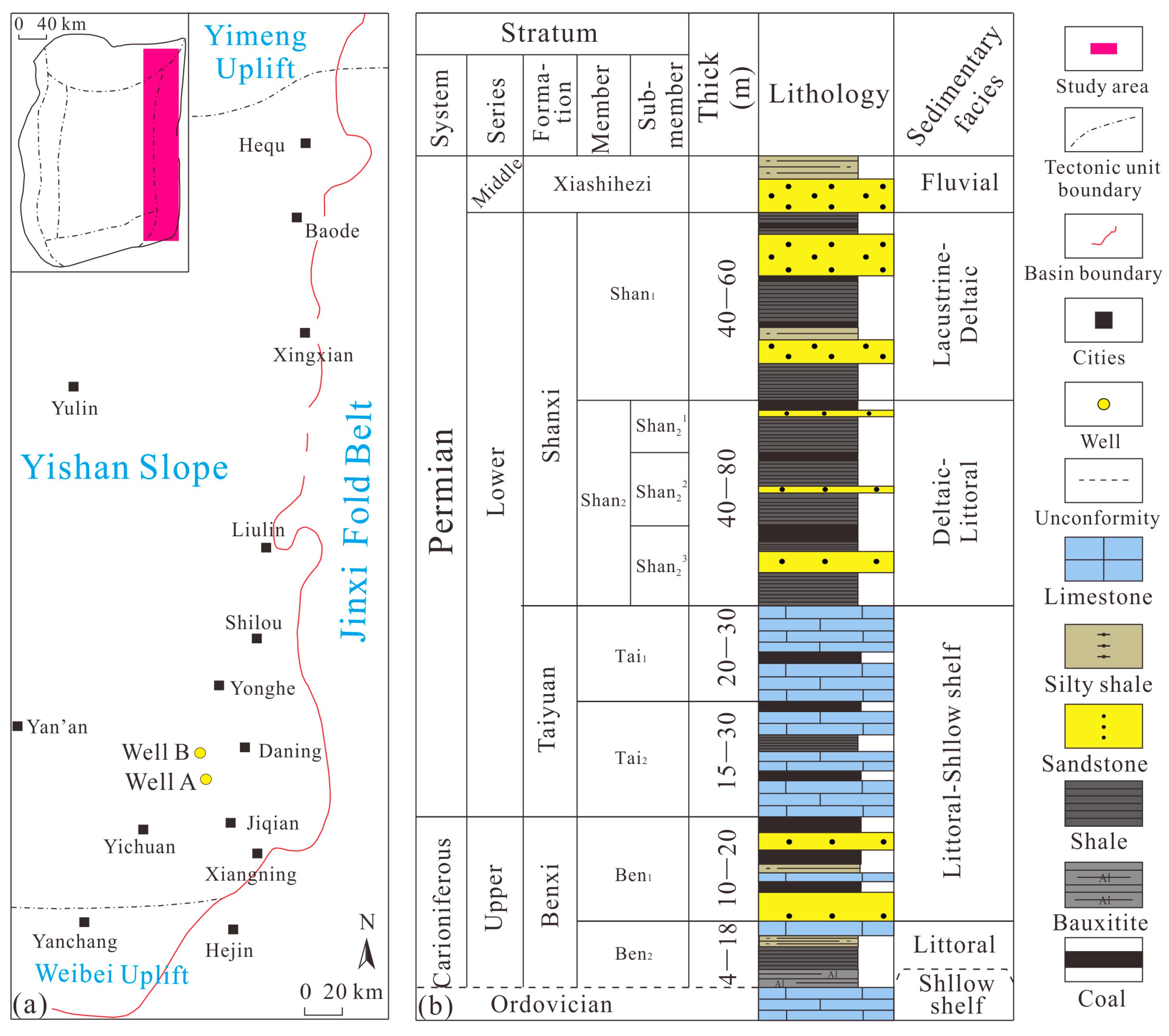
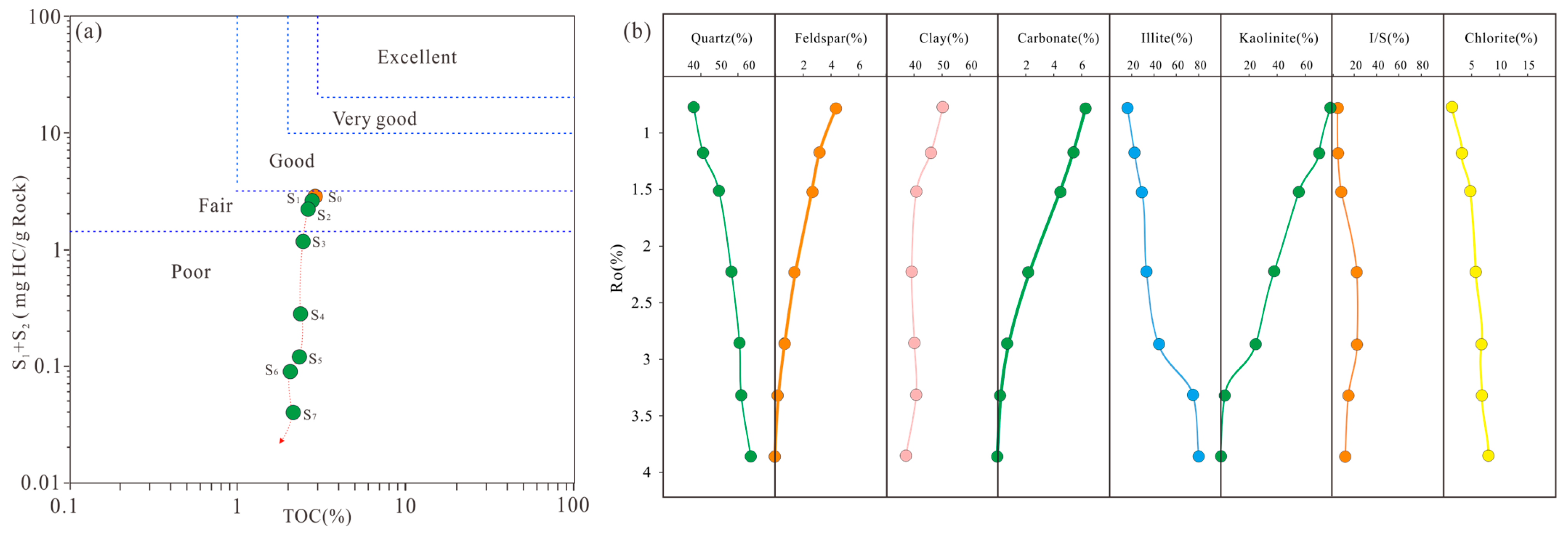



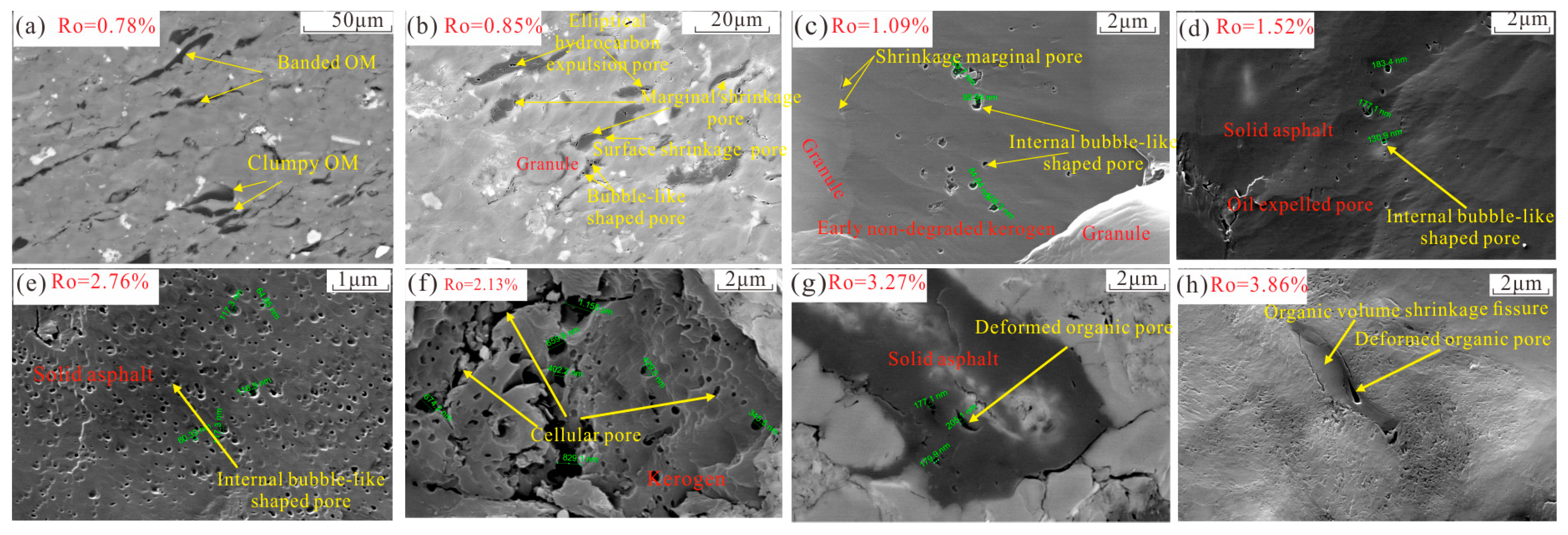
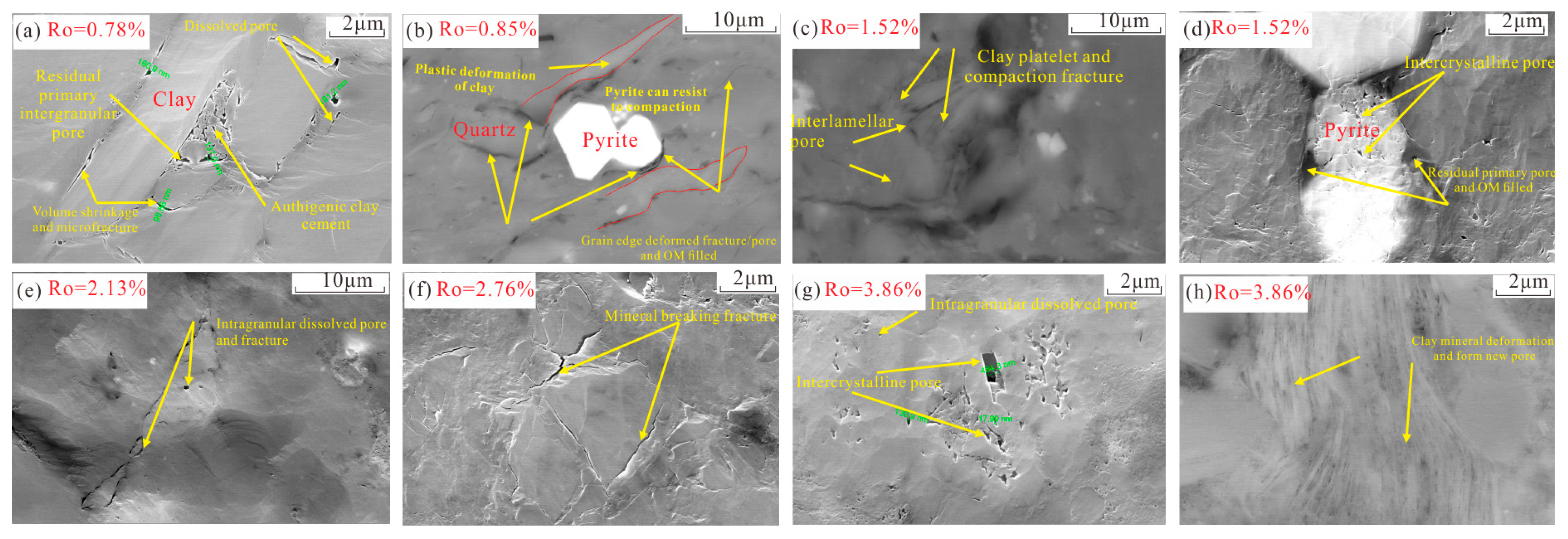
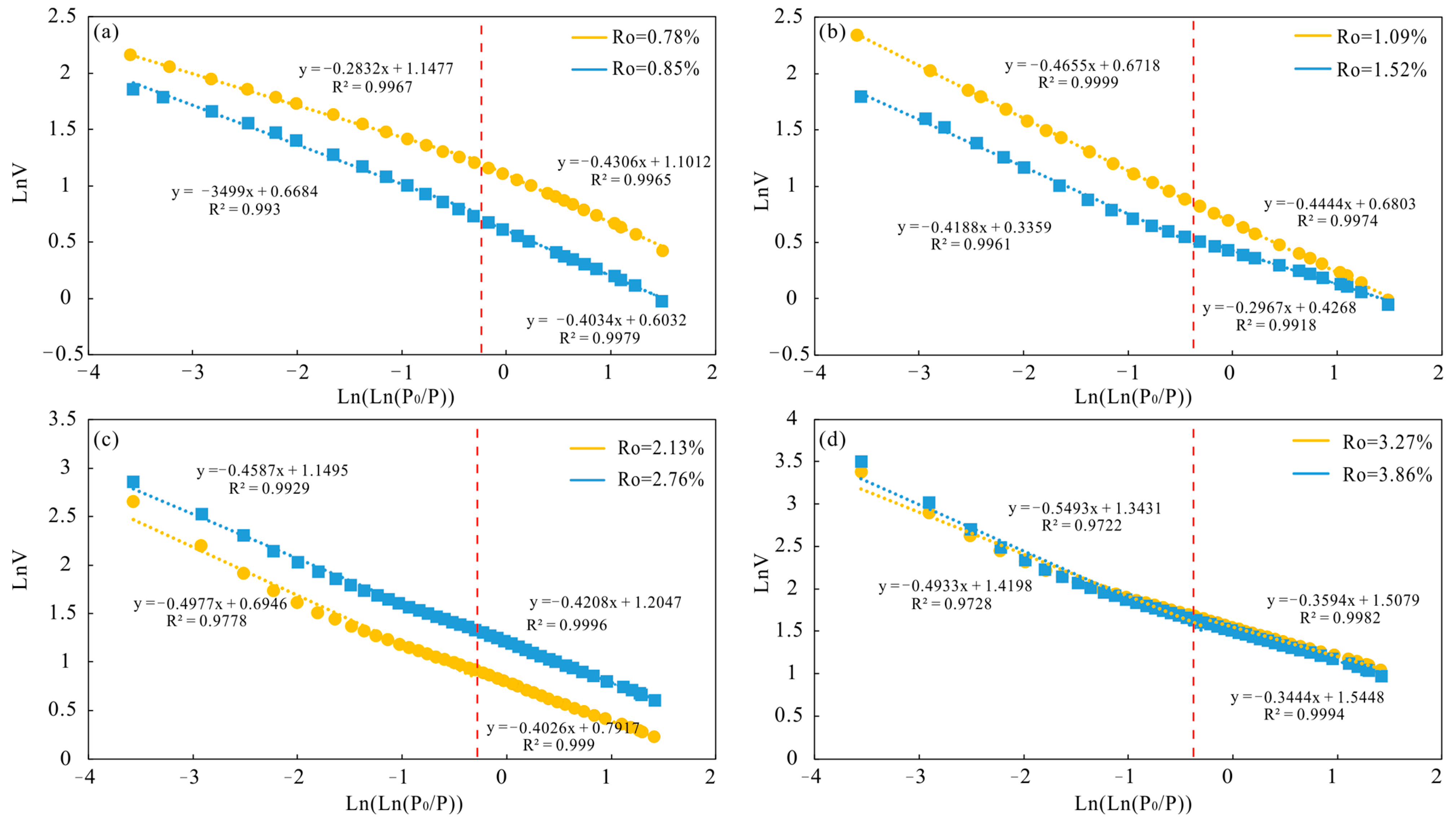

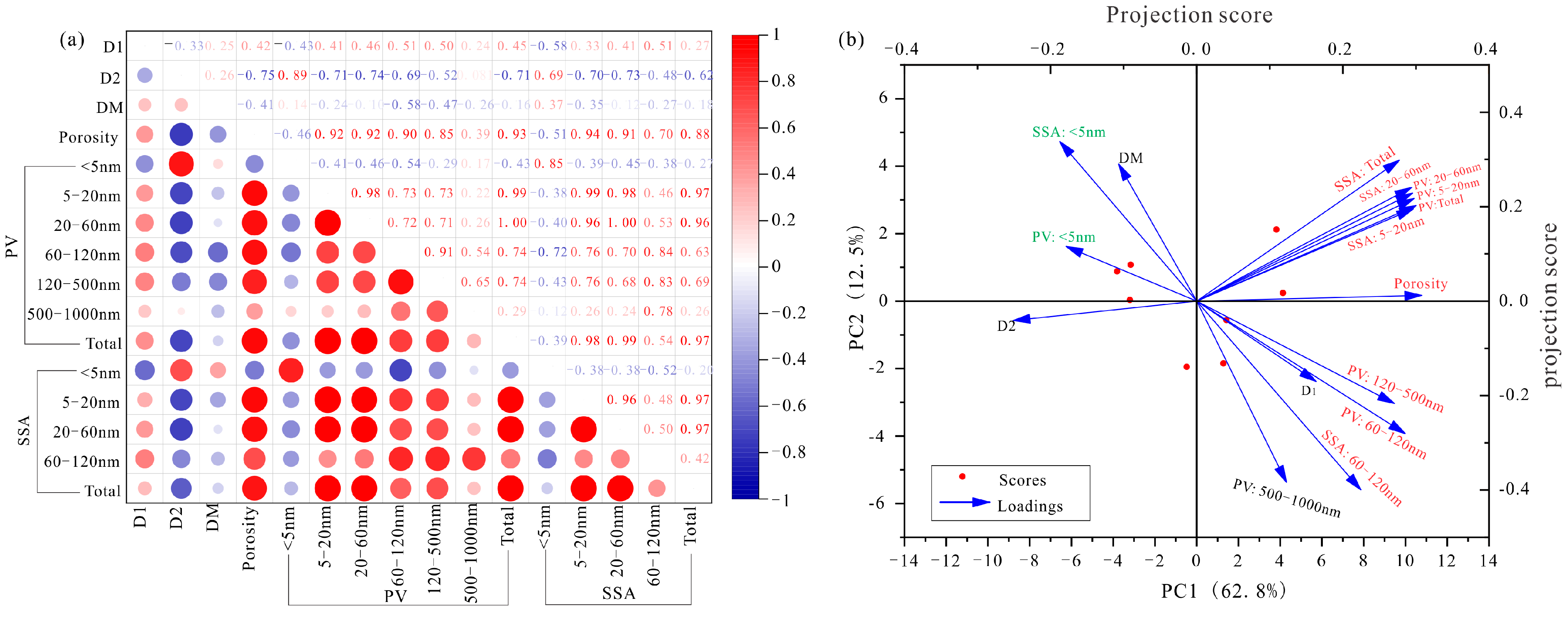

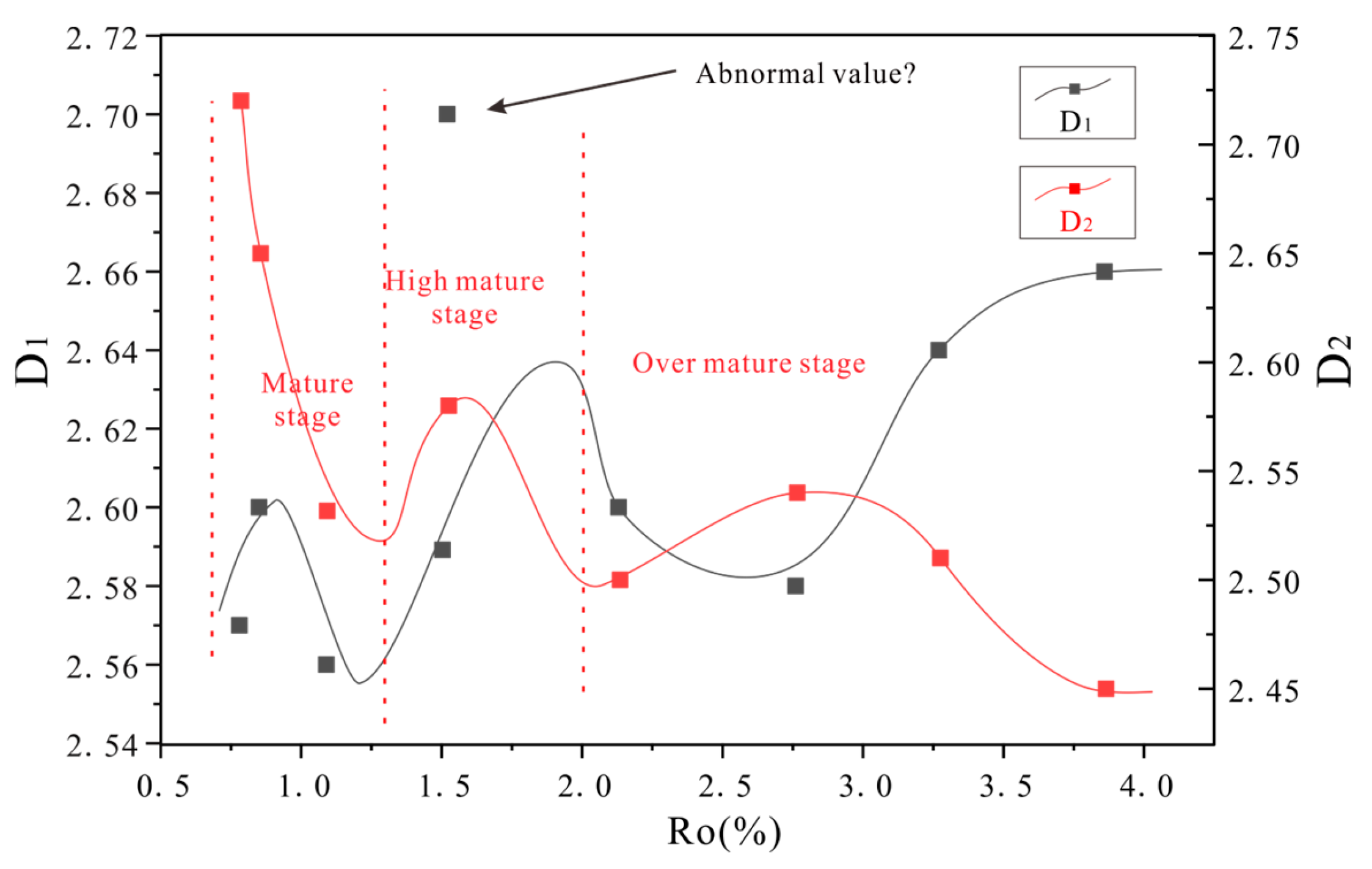
| Sample | Temperature (°C) | Static Rock Pressure (MPa) | Formation Pressure (MPa) | Holding Time (h) |
|---|---|---|---|---|
| S1 | 325 | 50 | 21 | 48 |
| S2 | 350 | 68 | 25 | 48 |
| S3 | 400 | 75 | 30 | 48 |
| S4 | 450 | 85 | 34 | 48 |
| S5 | 500 | 90 | 36 | 48 |
| S6 | 550 | 95 | 38 | 48 |
| S7 | 575 | 100 | 40 | 48 |
| Sample | Temperature (°C) | Ro (%) | TOC (%) | S1 + S2 (mg/g) | HI (mg/g TOC) | Quartz (%) | Feldspar (%) | Clay (%) | Dolomite (%) | Siderite (%) | Pyrite (%) | Kaolinite (%) | I/S (%) | Illite (%) | Chlorite (%) |
|---|---|---|---|---|---|---|---|---|---|---|---|---|---|---|---|
| S0 | Initial | 0.78 | 2.87 | 2.82 | 122 | 39.9 | 1.4 | 49.9 | 2.1 | 4.7 | 2.0 | 85 | 3 | 9 | 3 |
| S1 | 350 | 0.85 | 2.75 | 2.64 | 98 | 40.6 | 1.2 | 49.4 | 2.4 | 4.2 | 2.2 | 77 | 3 | 16 | 4 |
| S2 | 375 | 1.09 | 2.6 | 2.22 | 66 | 42.3 | 1.2 | 47.9 | 2.2 | 4.6 | 1.8 | 73 | 4 | 19 | 4 |
| S3 | 400 | 1.52 | 2.43 | 1.17 | 48 | 46.5 | 0.8 | 45.6 | 1.5 | 4.2 | 1.4 | 63 | 8 | 24 | 5 |
| S4 | 450 | 2.13 | 2.34 | 0.28 | 14 | 48.5 | 0.7 | 44.5 | 1.3 | 3.4 | 1.6 | 35 | 18 | 41 | 6 |
| S5 | 500 | 2.76 | 2.31 | 0.12 | 6 | 49.5 | 0.6 | 44.2 | 1.1 | 3.2 | 1.4 | 23 | 22 | 44 | 11 |
| S6 | 550 | 3.27 | 2.07 | 0.09 | 4 | 50.4 | 0.5 | 43.3 | 1.0 | 3.6 | 1.2 | 3 | 16 | 71 | 10 |
| S7 | 575 | 3.86 | 2.12 | 0.04 | 1 | 52.0 | 0.6 | 42.4 | 1.1 | 3.0 | 0.9 | 0 | 13 | 76 | 11 |
| Sample ID | Ro | Pore Volume (cm3/g) | Specific Surface Area (m2/g) | ||||||||||
|---|---|---|---|---|---|---|---|---|---|---|---|---|---|
| <5 nm | 5–20 nm | 20–60 nm | 60–120 nm | 120–500 nm | 500–1000 nm | Total | <5 nm | 5–20 nm | 20–60 nm | 60–120 nm | Total | ||
| S0 | 0.78 | 0.00111 | 0.00140 | 0.00065 | 0.00012 | 0.00019 | 0.00018 | 0.0037 | 1.415 | 0.311 | 0.072 | 0.017 | 1.814 |
| S1 | 0.85 | 0.00061 | 0.00138 | 0.00067 | 0.00015 | 0.00019 | 0.00017 | 0.0032 | 0.908 | 0.303 | 0.067 | 0.016 | 1.294 |
| S2 | 1.09 | 0.00040 | 0.00123 | 0.00081 | 0.00012 | 0.00013 | 0.00004 | 0.0027 | 1.040 | 0.231 | 0.087 | 0.014 | 1.373 |
| S3 | 1.52 | 0.00040 | 0.00207 | 0.00277 | 0.00056 | 0.00052 | 0.00018 | 0.0065 | 0.445 | 0.411 | 0.186 | 0.055 | 1.097 |
| S4 | 2.13 | 0.00024 | 0.00309 | 0.00661 | 0.00069 | 0.00046 | 0.00024 | 0.0113 | 0.311 | 1.073 | 0.844 | 0.069 | 2.298 |
| S5 | 2.76 | 0.00054 | 0.00492 | 0.00657 | 0.00070 | 0.00064 | 0.00017 | 0.0135 | 0.653 | 1.811 | 0.845 | 0.037 | 3.346 |
| S6 | 3.27 | 0.00054 | 0.00689 | 0.01558 | 0.00073 | 0.00084 | 0.00028 | 0.0249 | 0.935 | 2.336 | 1.960 | 0.078 | 5.309 |
| S7 | 3.86 | 0.00020 | 0.00787 | 0.01711 | 0.00059 | 0.00045 | 0.00010 | 0.0263 | 0.446 | 2.522 | 2.215 | 0.031 | 5.214 |
| Sample ID | Ro | 0.01 < P/P0 < 0.45 | 0.45 < P/P0 < 0.98 | HPMI (50 nm< r <1000 nm) | ||||||
|---|---|---|---|---|---|---|---|---|---|---|
| D1 | R2 | D2 | R2 | DM1 | R2 | DM2 | R2 | DM | ||
| S0 | 0.78 | 2.57 | 0.997 | 2.72 | 0.998 | 2.92 | 0.990 | 2.96 | 0.995 | 2.94 |
| S1 | 0.85 | 2.60 | 0.998 | 2.65 | 0.993 | 2.90 | 0.993 | 2.94 | 0.997 | 2.92 |
| S2 | 1.09 | 2.56 | 0.997 | 2.53 | 1.00 | 2.91 | 0.996 | 2.96 | 0.996 | 2.94 |
| S3 | 1.52 | 2.70 | 0.992 | 2.58 | 0.996 | 2.87 | 0.998 | 2.95 | 0.989 | 2.91 |
| S4 | 2.13 | 2.60 | 1.00 | 2.50 | 0.978 | 2.61 | 0.987 | 2.96 | 0.989 | 2.72 |
| S5 | 2.76 | 2.58 | 1.00 | 2.54 | 0.993 | 2.25 | 0.995 | 2.96 | 0.894 | 2.47 |
| S6 | 3.27 | 2.64 | 0.998 | 2.51 | 0.973 | 2.77 | 0.999 | 2.94 | 0.989 | 2.87 |
| S7 | 3.86 | 2.66 | 1.00 | 2.45 | 0.972 | 2.86 | 1.00 | 2.97 | 0.979 | 2.92 |
Disclaimer/Publisher’s Note: The statements, opinions and data contained in all publications are solely those of the individual author(s) and contributor(s) and not of MDPI and/or the editor(s). MDPI and/or the editor(s) disclaim responsibility for any injury to people or property resulting from any ideas, methods, instructions or products referred to in the content. |
© 2025 by the authors. Licensee MDPI, Basel, Switzerland. This article is an open access article distributed under the terms and conditions of the Creative Commons Attribution (CC BY) license (https://creativecommons.org/licenses/by/4.0/).
Share and Cite
Gu, Y.; Wu, X.; Jiang, Y.; Guan, Q.; Dong, D.; Zhuang, H. Evolution of Pore Structure and Fractal Characteristics in Transitional Shale Reservoirs: Case Study of Shanxi Formation, Eastern Ordos Basin. Fractal Fract. 2025, 9, 335. https://doi.org/10.3390/fractalfract9060335
Gu Y, Wu X, Jiang Y, Guan Q, Dong D, Zhuang H. Evolution of Pore Structure and Fractal Characteristics in Transitional Shale Reservoirs: Case Study of Shanxi Formation, Eastern Ordos Basin. Fractal and Fractional. 2025; 9(6):335. https://doi.org/10.3390/fractalfract9060335
Chicago/Turabian StyleGu, Yifan, Xu Wu, Yuqiang Jiang, Quanzhong Guan, Dazhong Dong, and Hongzhan Zhuang. 2025. "Evolution of Pore Structure and Fractal Characteristics in Transitional Shale Reservoirs: Case Study of Shanxi Formation, Eastern Ordos Basin" Fractal and Fractional 9, no. 6: 335. https://doi.org/10.3390/fractalfract9060335
APA StyleGu, Y., Wu, X., Jiang, Y., Guan, Q., Dong, D., & Zhuang, H. (2025). Evolution of Pore Structure and Fractal Characteristics in Transitional Shale Reservoirs: Case Study of Shanxi Formation, Eastern Ordos Basin. Fractal and Fractional, 9(6), 335. https://doi.org/10.3390/fractalfract9060335








